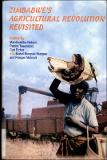| dc.contributor.author | Mehretu, Assefa | |
| dc.contributor.author | Mutambirwa, Chris C. | |
| dc.coverage.spatial | Zimbabwe. | en |
| dc.date.accessioned | 2015-08-24T14:23:08Z | |
| dc.date.available | 2015-08-24T14:23:08Z | |
| dc.date.issued | 2006 | |
| dc.identifier.citation | Mehretu, A. and Mutambirwa, C.C. (2006) Social Poverty Profile of Rural Agricultural Areas. In: Rukuni, M., Tawonezvi, P. and Eicher, C. (eds.) Zimbabwe's Agricultural Revolution Revisited. UZ, Mt. Pleasant, Harare: UZ Publications, pp. 119-140. | en |
| dc.identifier.isbn | 0869241419 | |
| dc.identifier.uri | https://opendocs.ids.ac.uk/opendocs/handle/20.500.12413/6808 | |
| dc.description | A book chapter/conference paper on poverty levels amongst Zimbabwe's rural agricultural communities. | en |
| dc.description.abstract | In examining the livelihoods of rural agricultural communities in Zimbabwe, this chapter offers an historical perspective on some of the challenges and opportunities facing the agricultural sector. As a former settler colony, Zimbabwe’s economy at the time of independence in 1980 was characterized by the commercialization of its agricultural activity together with a high degree of polarity between its commercial and communal sectors. This was evident in the duality of the country’s economic sectors, regional development, economy versus resource match and government role in territorial integration of commercial and communal farmers. At the base of the dual economy was the colonial division of resources and related demographics into two exclusive and counter-posed geographic domains: the commercial land and the communal land (former tribal trust lands).
This chapter describes the principal features of poverty in rural communities of Zimbabwe and the spatial mismatch between population density and land, potential problems behind growing land hunger, land degradation and declining agricultural yields. These negative conditions became harbingers for political change and inevitable post-independence land reforms, land redistribution and resettlement. Social poverty profiles of communal land communities are outlined, as well as those of the hitherto unnoticed black communities residing and working on the large-scale commercial farmland. The impact of poor accessibility to basic needs and services on the livelihoods of rural communities and their agricultural activities is also explained to highlight the need for rural development. | en |
| dc.language.iso | en | en |
| dc.publisher | University of Zimbabwe (UZ) Publications. | en |
| dc.rights.uri | http://creativecommons.org/licenses/by-nc-nd/3.0/ | en |
| dc.subject | Agriculture | en |
| dc.subject | Poverty | en |
| dc.subject | Rural Development | en |
| dc.title | Social Poverty Profile of Rural Agricultural Areas | en |
| dc.type | Book chapter | en |
| dc.type | Conference paper | en |
| dc.rights.holder | University of Zimbabwe (UZ) | en |


